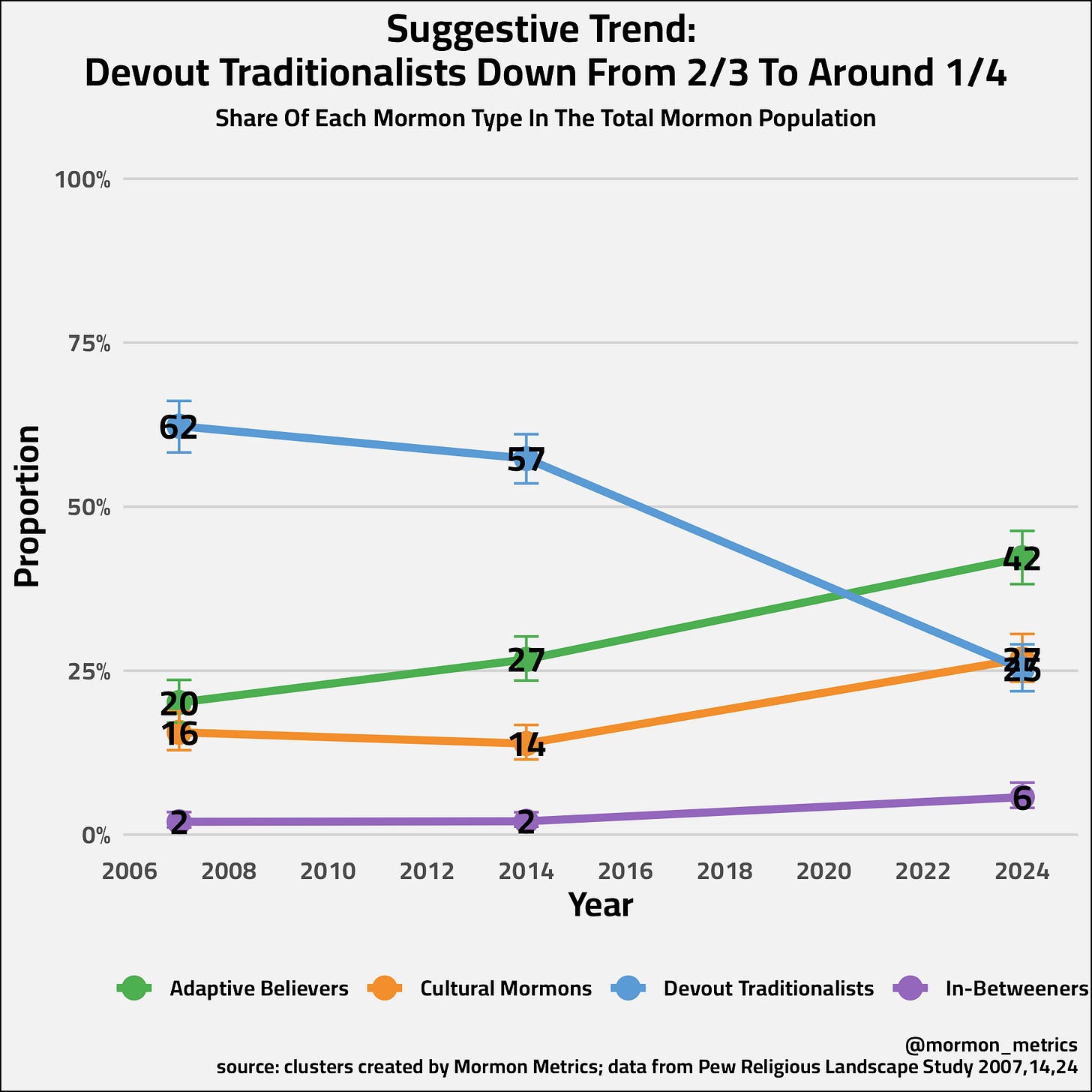The Mormon Typology: Mapping a Changing Faith
The Official Report is now released!

Update Sunday Sept. 7, 2025. I have gotten a lot of great feedback and I incorporated much of it in the latest version. For example, in my opening chart, I now have confidence intervals. I also edited the caption of my charts to say “clusters created by Mormon Metrics; data from Pew Religious Landscape Study” to mitigate potential confusion. None of the code or clusters have changed - only contextual and clarity changes. The typology presented here is exploratory and suggestive, not definitive. Chart-level notes indicate where patterns are validated by pooled data versus more tentative. The main findings — the decline of Devout Traditionalists and the emergence of a more plural Mormon landscape — remain unchanged. You can read the full list of changes in the addendum in the latest version linked below!
For much of the last century, the Latter-day Saint community was often portrayed as a monolith — devout, conservative, and uniform. But that picture no longer holds. Mormonism in 2025 is not a single voice, but a spectrum of identities.
Today I’m releasing the Mormon Typology Report, a 40-page analysis based on three waves of the Pew Religious Landscape Study (2007, 2014, and 2024). Using clustering analysis, I identify four groups of self-identified Mormons — each with its own beliefs, practices, and cultural identity. (scroll to bottom for link to download!)
Key Findings
The Devout May No Longer Define Mormonism. In 2007, nearly two-thirds of Mormons were Devout Traditionalists. By 2024, that share appears to have dropped to about one-quarter.
Adaptive Believers May Represent the New Mainstream. Now the largest group (about 42%), these Mormons still attend and believe, but seem more flexible on social and political issues.
Cultural Mormonism Appears to Be Growing. Nearly one in three (27%) identify with Mormonism more as heritage than as regular practice.
In-Betweeners Are Emerging. A small but suggestive group (around 6%) doubt God’s existence yet still identify as Mormon, pointing toward possible future exits.
Politics May Be Shifting. While Republican identity remains strong, many Adaptives, Cultural Mormons, and In-Betweeners hold views that often align more closely with the U.S. mainstream on same-sex marriage, abortion, and science.
Meet the Groups
Devout Traditionalists
The faithful core of Mormonism, Devout Traditionalists appear highly committed to practice and belief. They typically attend church weekly, pray and study scripture regularly, and see Mormonism as the one true faith. Demographically, they tend to lean more male, white, and concentrated in Utah and the Mountain West. While they remain vital to church leadership and culture, their share of the LDS population appears to have declined sharply since 2007.
Adaptive Believers
Now the largest group, Adaptive Believers remain active in the church but seem to take a more flexible approach to both doctrine and politics. They attend services and maintain belief, yet often show more openness to science, pluralism, and social change than their devout counterparts. They appear somewhat more educated on average than the other groups and may represent a middle ground between orthodoxy and cultural identity. Their growth suggests a Mormonism that adapts to modern realities while holding onto core commitments.
Cultural Mormons
For Cultural Mormons, identity seems to matter more than practice. They rarely attend services, pray, or read scripture, but still see “Mormon” as part of their identity. This group appears to have grown, and seems to be more prominent outside the Mormon heartland. Like cultural Catholics or Jews, they may represent a form of belonging that persists even when belief and observance fade.
In-Betweeners
A smaller but distinct group, In-Betweeners occupy the gray space between faith and exit. Many express doubts about God’s existence or Mormon exclusivity, yet continue to identify as LDS. They may attend occasionally or remain socially connected, but they seem to live in tension with orthodox expectations. Some may eventually move toward cultural identity or disaffiliation altogether, making this group a suggestive bellwether of future change.
Why It Matters…
For wards and congregations:
The pews may no longer be dominated by the most orthodox. Adaptive Believers appear to make up more than half of weekly attenders.For politics:
The long-standing idea of a uniformly Republican “Mormon vote” seems to be cracking. Internal diversity may increasingly shape Utah elections and national narratives.For the future:
Mormonism may be evolving into multiple modes of belonging — some devout, some cultural, some in-between.
Read the Full Report
This is the most modern comprehensive data-driven typology of Mormons. You can read or download the full 40-page report HERE.
I hope this typology sparks conversation about where the LDS community has been, where it is now, and where it’s heading.
The next few weeks, I’ll continue to publish different aspects and nuances in this typology.
See you next week!



This is really cool, well done. I have a follow-up question. I saw in the report that Devout Traditionalists answer 77% “very happy” while the next highest is around half that (35% or something?). Is the magnitude of the difference really that large? I don’t have reason to doubt that there is an effect, but an effect magnitude that big is worth double checking. It’s very interesting if true and I would love to see follow-up on that. Thanks again for all your work on this.
Now THIS is podracing!! I'm excited to see more from this report in the future!